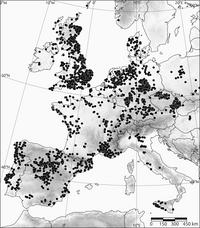
Maritime Encounters
Short description
This project’s central aim is to fill persistent gaps, opened by recent studies based on archaeology and aDNA, to understand maritime dimensions of migration, mobility and exchange along the Atlantic façade from Norway to Iberia. We will investigate the evolution of prehistoric maritime technologies and navigational capabilities on seas, rivers and lakes, and their role in major migrations.
This project’s central aim is to fill persistent gaps, opened by recent studies based on archaeology and aDNA, to understand maritime dimensions of migration, mobility and exchange along the Atlantic façade from Norway to Iberia.
We will investigate the evolution of prehistoric maritime technologies and navigational capabilities on seas, rivers and lakes, and their role in major migrations, including:
- direct and indirect evidence for prehistoric boats and boat building, exploitation of marine resources;
- maritime and other water-based movements of humans, animals, lithics, metals, amber and other valuable raw materials;
- model ancient sea crossings and navigation using novel methods from oceanography;
- the contribution of indigenous knowledge and traditions to innovations at each stage and transitional episode;
- the respectively roles of down-the-line versus direct long-distance contact in moving people, materials, ideas and languages.
The encounters of ~3400–2300 BC between the Pitted Ware Culture in Scandinavia and pastoral groups with steppe ancestry who crossed the Baltic and Kattegat and Skagerrak. (subproject 1)
The encounters between the Bell Beaker/Beaker cultures and indigenous groups along the Atlantic façade ~2800–2100 BC. (subproject 2)
Long-distance interaction developing between Scandinavia and the metal-rich Atlantic façade ~2100–1400 BC. (subproject 3)
Maritime connections extending from Scandinavia to Iberia. ~1400/1300–600 BC. (subproject 4)
Our ultimate objective—a synthetic transdisciplinary overview of European prehistory from a maritime perspectiv is ambitious, carrying the potential risk of overreaching. Therefore, our work plan focuses tightly on four specialised subprojects in research areas in which the participants and participating institutions have relevant world-recognised expertise and track records.
Each Subproject will yield new high-quality datasets to fill lingering gaps in the understanding of Europe’s maritime and riverine prehistory.

Dr Christian Horn, Subproject 1
Dr Marc Vander Linden, Subproject 2

Professor Johan Ling, Subproject 3
Dr Marta Diaz-Guardamino, Subproject 4
We propose a transdisciplinary approach building on data, methods, and theories from six discourses.
International and cross disciplinary
- Archaeology
- Oceanography
- Archaeogenetics
- Archaeolinguistics
- Social theory
Program team: Professor Johan Ling, Professor Sir Barry Cunliffe, Dr Marta Díaz-Guardamino, Dr Marc Vander Linden, Dr Christian Horn, Professor Johan Koch, Professor Marcos Hunt Ortiz, Professor Alvaro Montenergo, Dr Magnus Artursson, Dr Aurélien Burlot, Dr Boel Bengtsson, Dr Guus Kroonen, ProfessorMartin Sikora, Dr Serena Sabatini, Dr Knut Austvoll, Dr Zofia Stos- Gale, Dr Cecilia Lindhé, Professor Richard Chacon, Dr Mikael Fauvelle.








